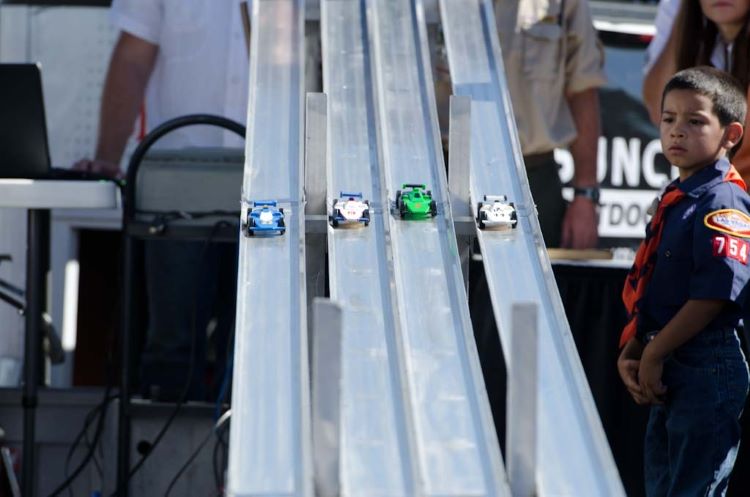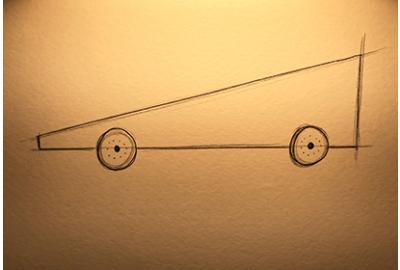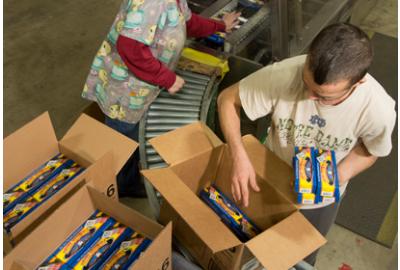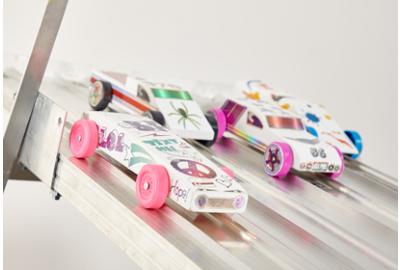5 Tips to Building the Fastest Pinewood Derby Car
5 Tips to Building the Fastest Pinewood Derby Car
There's no better way to keep your Scout's mind engaged over the holiday break than by helping them build the ultimate car for the upcoming Pinewood Derby season. Mind you, our team isn't composed of top-notch physicists or race engineers (though we do have some impressive Scouting America alumni you could read about here), but make no mistake—we know a thing or two about designing a fast car. To aid your Scout with the perfect build-out, here are five simple tips for creating a fast car for the Pinewood Derby.


5 Tips to Building the Fastest Pinewood Derby Car
- Lubricate the wheels with graphite
- Bake the wood block
- Use axle guards
- Smooth the axles
- Choose the right car shape
1. Lubricate the Wheels with Graphite
When designing your car, it's essential to remember that friction is not your friend. Too much friction slows the car as gravity helps it race down the track. To reduce friction and ensure an ultra-fast car, lubricate the metal axles. However, ensure you follow the rules so your Scout isn't disqualified! Although regulations may vary by Troop, rule 6 of the Scouting America's Pinewood Derby Car Building Rules states, "No lubricating oil may be used. The axles may be lubricated with powdered graphite or silicone." Fortunately, you can purchase affordable, high-carbon graphite here at the Scout Shop. The Pinewood Derby High-Speed Graphite is an odor-free, extra-fine dry powdered lubricant. Scouts must use graphite with adult supervision.
2. Bake the Wood Block
Ideally, a fast car is one with a lower center of gravity to the ground. In a nutshell, the lower the center of gravity, the more stability your car has throughout the race. Per the Pinewood Derby rules, the car's weight shouldn't exceed 5 ounces. One way to ensure your car doesn't exceed the weight limit is to bake the block! Naturally, wood holds water, and water adds weight. You'll want to help your Scout by baking the block in an oven at 250 degrees for one hour. Let the block cool overnight. Then, weigh the block quickly and accurately with a Pinewood Derby scale. Evaporating the water inside the wood allows you to distribute the weight differently, ideally toward the car's rear.
3. Use Axle Guards
Consistency is the key to success. After your Scout builds an awesome car, help ensure it operates at peak performance after more than one race. Frequently, cars leap off the tracks, knocking the axles out of alignment and ruining hours of precious work. Consider the Pinewood Derby Axle Guard to save the day and keep your Scout's car in tip-top shape. The axle guard installs easily, and the under-car plate has a ridge that slides right into the pre-cut axle groove to secure the axle to the car's body. Its unique design allows for adequate track clearance and has no interference with car performance!
4. Smooth the Axles
Axles often arrive with slight imperfections, bumps, and grooves that should be smoothed out. The smoother the axle, the less friction it generates and the faster the car travels. Thankfully, sandpaper does the trick. The Scout Shop has this convenient high-speed kit that contains three different sandpaper grits and allows you to mount the wheels on an electric drill for better sanding results. We recommend medium grit sandpaper for smoothing.
5. Choose the Right Car Shape
The truth is there are many ideas online, but with so many car designs, how do you decide what car shape to use? To make your Pinewood Derby car-building experience much more accessible, we've compiled a short list of 5 essential car shapes that you can read more about here. When deciding on a car shape, slim isn't always better. Instead, focus more on the weight distribution of the Pinewood Derby car. For a fast car, you want the add more weight to the rear. The arrow car shape, for example, has a definite pointier front and slim body with cut-in sides that lead to a flared back end. You will want to ensure that the weight is slightly heavier near the rear wheel axle, so add weight to the flared back end. With so much of the wood cut out, the weight department leaves plenty of space to add weight back precisely where it counts!


Pinewood Derby Car Building Safety is Top Priority
Building a car is lots of fun, and the project provides the perfect opportunity for parents to make lifelong memories with their Scouts. To help everyone stay safe, monitor your Scout's use of tools, always wear goggles to protect the eyes, and don't wear loose-fitting clothing! Here’s a list of some useful safety guidelines found on the Scout Shop website.
- Gather your safety essentials: dust mask, goggles, and latex gloves.
- Wear eye protection at all times.
- Monitor Cub Scouts' use of tools.
- Wear a dust mask when appropriate.
- Work in a well-lighted and well-ventilated area.
- Consider wearing gloves when using sharp tools.
- Do not wear loose-fitting clothing.
- Do not melt lead; handle lead with care.
- Follow all safety rules and precautions listed on your tools and products.
- Keep your work area clean and organized.
Ready for the Pinewood Derby
Order the official Scouting America Pinewood Derby car kit here. The kit has one car body (woodblock), wheels, axles, and one set of small, black number decals. Do you know any tips and tricks to build the perfect Pinewood Derby car? Drop them in the comments below, and remember to shop all your Pinewood Derby gear at ScoutShop.org—the official online retail store of the Scouting America!



















